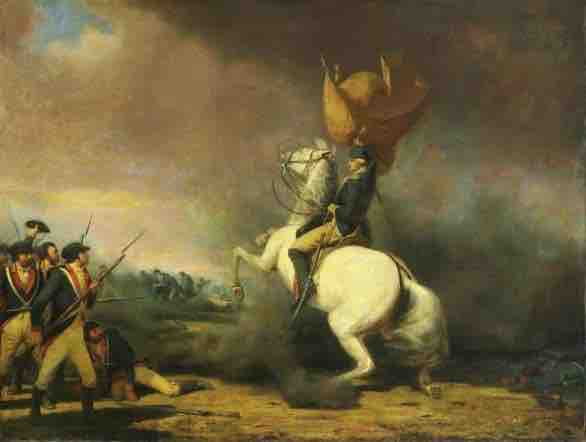Quebec
The invasion of Canada in 1775 was the first major military initiative by the newly formed Continental Army during the American Revolutionary War. The objective of the campaign was to gain military control of the British Province of Quebec and to persuade the French-speaking Canadiens to support the revolution.
Forces under Major General Richard Montgomery captured Fort St. Johns, the main defensive point south of Montreal, in November 1775. British General Guy Carleton quickly abandoned Montreal, fleeing to Quebec City, and Montgomery took control of Montreal.
A simultaneous expedition left Cambridge, Massachusetts under Benedict Arnold and traveled with great difficulty through the wilderness of Maine to Quebec City. This arduous trek left Arnold's surviving troops starving and lacking in basic supplies and equipment. Montgomery joined Arnold outside of Quebec with an army much reduced in size due to expiring one-year enlistment terms.
In December 1775, Montgomery and Arnold's combined forces were defeated at the Battle of Quebec. The battle was a disastrous defeat for the Patriots. Montgomery was killed and Arnold wounded. Arnold then conducted an ineffectual siege on the city, but was driven over the border, back to Fort Ticonderoga. The Patriot forces were disorganized and weakened by smallpox by this point. Meanwhile, Loyalist sentiments in Canada were boosted by successful propaganda campaigns launched by the British.
New York and New Jersey
In the summer of 1776, General William Howe and 30,000 British troops attacked and defeated General George Washington's Continental forces in the Battle of Long Island. Washington skillfully managed a narrow escape, retreating across the East River to Manhattan Island. In September, General Howe landed about 12,000 men in lower Manhattan, quickly taking control of New York City.
The failure of the Continental Army to hold New York strengthened Loyalist sentiment in the region. Spirits were low among the Continental troops and popular support for the war was wavering. Washington's army had dwindled to fewer than 5,000 men fit for duty and would be significantly reduced after enlistments expired at the end of the year.
News of the capture of New York was favorably received in London, and General Howe was awarded the Order of the Bath for his work. Combined with news of the recovery of Quebec, circumstances suggested to British leaders that the war could soon be won. Britain maintained control of New York City until the war ended in 1783, using it as a base for operations elsewhere in North America.
Meanwhile, Washington's army organized attacks on British outposts already battling ongoing militia and army raids as he was repulsed from New York by the British. In mid-December, Washington planned a two-pronged attack on an outpost in Trenton, including a third diversionary attack in Bordentown. On the evening of December 25, 1776, Washington led 2,400 of his men across the treacherous Delaware River to ambush Hessian soldiers guarding the British fort at Trenton. The German soldiers were completely caught off guard and the Continental Army quickly triumphed at the Battle of Trenton, killing or capturing nearly 1,000 Hessians. This victory increased Patriot morale and recruitment.
The victory also drew General Charles Cornwallis from New York. Cornwallis reassembled an army of more than 6,000 men and marched most of them against a position Washington was holding south of Trenton. He then stationed a garrison of 1,200 at Princeton and attacked Washington and his men on January 2, but was repulsed three times before darkness set. That night, Washington stealthily moved his troops again, intending to attack the garrison Cornwallis left at Princeton. The British lost more than a quarter of their forces in the battle and convinced General Howe to withdraw most of his army from New Jersey, with only outposts at New Brunswick and Perth Amboy remaining. Though the Americans suffered significant casualties and lost important supplies, Washington retained the core of his army and had successfully retaken most of the state from the British.
After both British and Continental Army troops entered their winter quarters in early January, Continental Army forces from New Jersey and Pennsylvania engaged in numerous scouting and harassing operations against British and German troops quartered in New Jersey. Cornwallis’ troops were attacked as they attempted to forage for provisions and the Continental Army employed scorched earth tactics to further deny supplies to the British. The Continental Army was bolstered during these skirmishes by a large number of militia from New Jersey, New York, and Pennsylvania. Though both armies laid elaborate traps for each other, the Patriots held an advantage due to their superior knowledge of the regional geography. Northern and coastal New Jersey continued to be the site of skirmishing and raiding by the British forces that occupied New York City for the duration of the war.

General George Washington rallying his troops at the Battle of Princeton, by William Ranney, 1848
Washington's victory at Princeton bolstered Patriot morale.